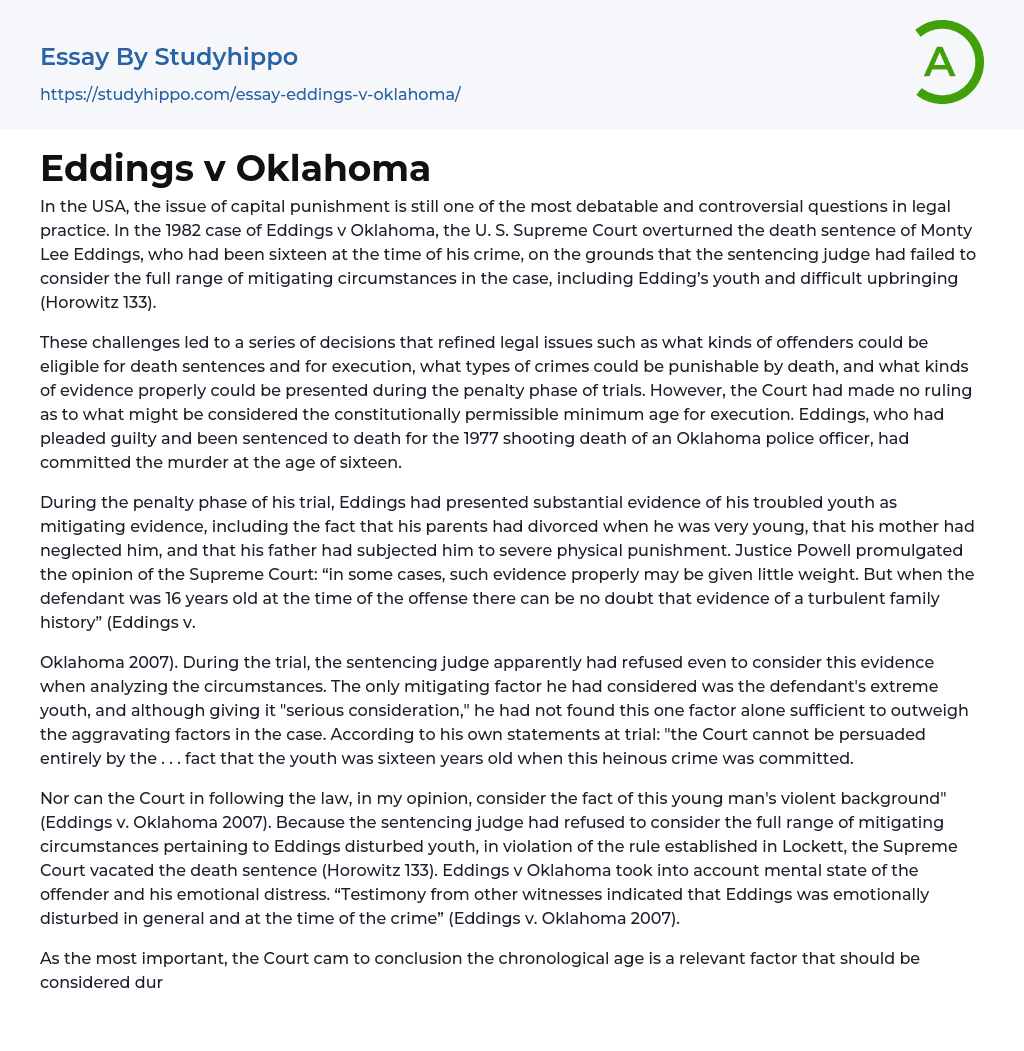In the USA, the issue of capital punishment is still one of the most debatable and controversial questions in legal practice. In the 1982 case of Eddings v Oklahoma, the U. S. Supreme Court overturned the death sentence of Monty Lee Eddings, who had been sixteen at the time of his crime, on the grounds that the sentencing judge had failed to consider the full range of mitigating circumstances in the case, including Edding’s youth and difficult upbringing (Horowitz 133).
These challenges led to a series of decisions that refined legal issues such as what kinds of offenders could be eligible for death sentences and for execution, what types of crimes could be punishable by death, and what kinds of evidence properly could be presented during the penalty phase of trials. However, the
...Court had made no ruling as to what might be considered the constitutionally permissible minimum age for execution. Eddings, who had pleaded guilty and been sentenced to death for the 1977 shooting death of an Oklahoma police officer, had committed the murder at the age of sixteen.
During the penalty phase of his trial, Eddings had presented substantial evidence of his troubled youth as mitigating evidence, including the fact that his parents had divorced when he was very young, that his mother had neglected him, and that his father had subjected him to severe physical punishment. Justice Powell promulgated the opinion of the Supreme Court: “in some cases, such evidence properly may be given little weight. But when the defendant was 16 years old at the time of the offense there can be no doubt that evidence o
a turbulent family history” (Eddings v.
Oklahoma 2007). During the trial, the sentencing judge apparently had refused even to consider this evidence when analyzing the circumstances. The only mitigating factor he had considered was the defendant's extreme youth, and although giving it "serious consideration," he had not found this one factor alone sufficient to outweigh the aggravating factors in the case. According to his own statements at trial: "the Court cannot be persuaded entirely by the . . . fact that the youth was sixteen years old when this heinous crime was committed.
Nor can the Court in following the law, in my opinion, consider the fact of this young man's violent background" (Eddings v. Oklahoma 2007). Because the sentencing judge had refused to consider the full range of mitigating circumstances pertaining to Eddings disturbed youth, in violation of the rule established in Lockett, the Supreme Court vacated the death sentence (Horowitz 133). Eddings v Oklahoma took into account mental state of the offender and his emotional distress. “Testimony from other witnesses indicated that Eddings was emotionally disturbed in general and at the time of the crime” (Eddings v. Oklahoma 2007).
As the most important, the Court cam to conclusion the chronological age is a relevant factor that should be considered during investigation and trial processes. After this case, in deciding in favor of considering more mitigating factors, the Supreme Court increased the possibility for more fully informed sentencing decisions, but it also increased the likelihood of arbitrary death sentences. In counterpoint to the move to expand the range of relevant mitigating factors, the Court also ruled on the constitutionality of broadening
the types of aggravating factors that might be considered during sentencing.
Here, however, it held the line more rigidly (Siegel et al 45). On one hand, the Court ruled that prosecutors could introduce psychiatric testimony regarding a defendant's potential future dangerousness, even though such testimony often is unreliable. On the other, the Court denied prosecution attempts to introduce victim impact statements, ruling that they were not relevant for determining whether the death penalty should be invoked. Legislative bodies were actively involved in developing new capital statutes and revising existing statutes in response to evolving legal standards and public concerns throughout this period.
- Criminal Justice System essays
- Affirmative Action essays
- Assisted Suicide essays
- Capital Punishment essays
- Censorship essays
- Child Labour essays
- Child Protection essays
- Civil Rights essays
- Corporal Punishment essays
- Death Penalty essays
- Empowerment essays
- Euthanasia essays
- Gay Marriage essays
- Gun Control essays
- Human Trafficking essays
- Police Brutality essays
- Privacy essays
- Sex Trafficking essays
- Speech essays
- Animal Cruelty essays
- Charles Manson essays
- Crime Prevention essays
- Crime scene essays
- Criminal Justice essays
- Criminology essays
- Cyber Crime essays
- Damages essays
- Detention essays
- Distracted Driving essays
- Drug Trafficking essays
- Drunk Driving essays
- Forensic Science essays
- Gang essays
- Hate Crime essays
- Homicide essays
- Identity Theft essays
- Juvenile Crime essays
- Juvenile Delinquency essays
- Juvenile Justice System essays
- Law Enforcement essays
- Murder essays
- Organized Crime essays
- Penology essays
- Piracy essays
- Prison essays
- Property Crime essays
- Prostitution essays
- Punishment essays
- Punishments essays
- Rape essays




